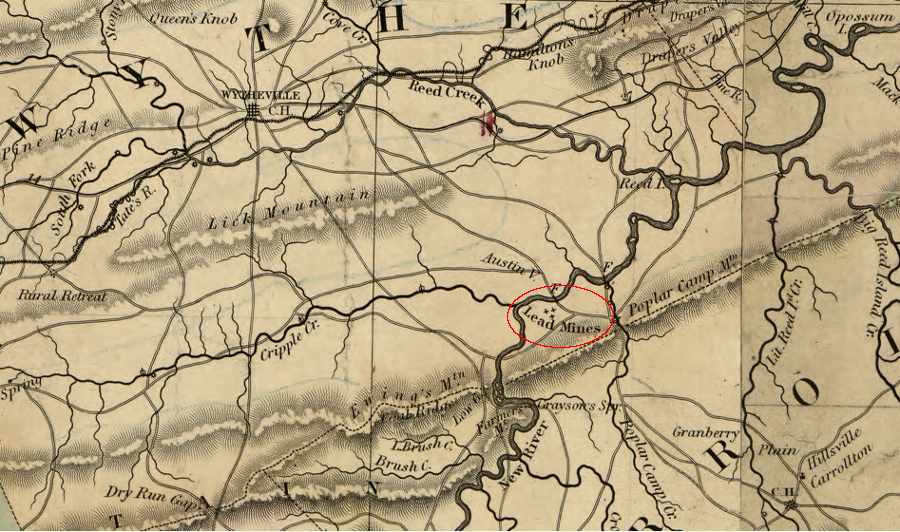Lead Mining at Austinville

the lead mines on the New River in Wythe County were operated by Moses Austin, but he failed to generate a profit and moved to Missouri
Source: Library of Congress, A map of the state of Virginia, constructed in conformity to law from the late surveys authorized by the legislature and other original and authentic documents (1859)
Col. John Chiswell discovered the lead deposits in what was then Augusta County in 1756, supposedly when hiding in a cave from Native Americans. He was running an iron furnace near Fredericksburg and recognized the value of the vein in the dolomite bedrock. The cave did not extend far into the cliff, so Chiswell had enough sunlight to recognize the different rock types.
Chiswell developed the Lead Mine Company with help from two wealthy and politically-influential investors, Colonel William Byrd III and John Robinson. Robinson was his son-in-law and Speaker of the Virginia House of Burgesses.1
Chiswell died in 1766, after killing a man in at Mosby Tavern in Cumberland County while traveling home to Williamsburg from the lead mine. Four months later, Chiswell was essentially under house arrest when he died (perhaps by suicide) at his home. Earlier same year Speaker Robinson died. His executors discovered Robinson had been lending public money illegally to other members of the Virginia elite, creating the biggest financial scandal in the history of Virginia as a colony. It took fifty years to settle John Robinson's estate.2
Chiswell never patented the land he was mining. There was no need to pay the costs of acquiring clear title; with Robinson and Byrd as partners, the colony was not going to give anyone else the right to claim the property.
During the American Revolution, the colony and then Commonwealth of Virginia operated the lead mines to produce the raw material needed for bullets. In 1791 Colonel Charles Lynch finally patented 1400 acres, to be run by the Lead Nine Company. However, in 1790 the brothers Moses and Stephen Austin had purchased from the state its right to operate the lead mines. The Austins left for Texas by 1798 and did not finish paying their debt to the state. A former blacksmith at the mine, Thomas Jackson, purchased it at auction in 1806.
Jackson and David Pierce arranged to run separate operations to extract the lead. Jackson built a tower where lead was melted and dropped 150 feet, forming round pellets before landing in a pool of water. The "shot tower" is now a state park, after being owned by the Daughters of the American Revolution between 1929-1952 and the Lead Mines Ruritan Club between 1952-1964.3
Links
- American Society of Mechanical Engineers
- Virginia Department of Energy

enslaved workers captured while fleeing to the British during the Revolutionary War were forced to work in the lead mines
Source: Journal of the House of Delegates of the Commonwealth of Virginia (June 10, 1779)
References
1. Jess Lowry, "Shot Tower Historical State Park and Jackson's Ferry," New River Symposium, 1984, http://npshistory.com/series/symposia/new_river/sec1.htm; Mary B. Keley, "Fort Chiswell and Chiswell's Lead Mines of Wythe County, Virginia: A New Perspective," Smithfield Review, Volume XIV (2010), https://vtechworks.lib.vt.edu/items/cdb72669-552e-4446-a5e2-ff516f492f97 (last checked January 10, 2024)
2. Mark Wilcox, "Was it Murder in Virginia?," Emerging Revolutionary War Era, January 28, 2026, https://emergingrevolutionarywar.org/2016/01/28/was-it-murder-in-virginia/; Brent Tarter and Dictionary of Virginia Biography, "John Robinson (1705–1766)," Encyclopedia Virginia, Virginia Humanities, December 7, 2020 (last checked January 10, 2024)
3. Jess Lowry, "Shot Tower Historical State Park and Jackson's Ferry," New River Symposium, 1984, http://npshistory.com/series/symposia/new_river/sec1.htm
Rocks and Ridges - The Geology of Virginia
Virginia Places

